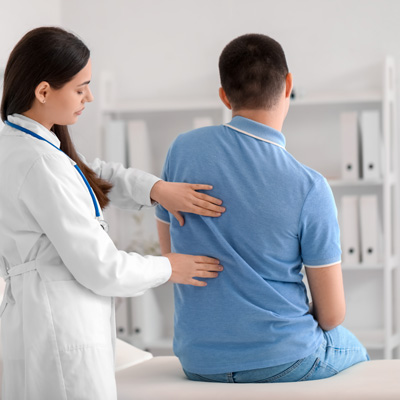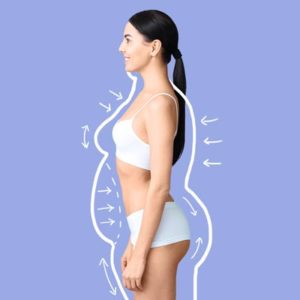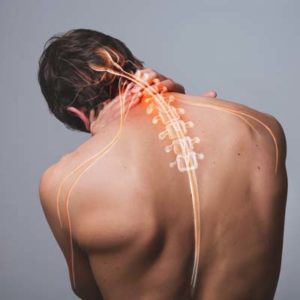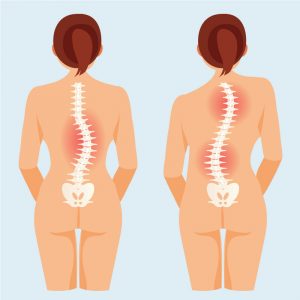Last Modified on August 29, 2025 by Dr. Tyler Meier

As a chiropractor in Newport Beach, we frequently hear patients ask, “Can bad posture cause scoliosis?” It’s a question that comes up almost daily in our practice, especially from concerned parents watching their teenagers hunch over devices or adults experiencing back pain from desk jobs.
The straightforward answer might surprise you: No, bad posture does not cause scoliosis. However, the relationship between posture and scoliosis is more nuanced than a simple yes or no.
Quick Answer: Does Bad Posture Cause Scoliosis?
Let’s clear this up right away. Bad posture does not cause scoliosis. This is one of the most persistent myths we encounter in chiropractic practice, and it’s time to set the record straight.
Scoliosis is a structural condition where the spine curves sideways in an “S” or “C” shape. According to research by Dr. Stuart Weinstein published in the Journal of Bone and Joint Surgery, approximately 80-85% of scoliosis cases are idiopathic, meaning the exact cause remains unknown. The remaining cases stem from congenital abnormalities, neuromuscular conditions, or degenerative changes.
However, here’s where it gets interesting: while poor posture doesn’t create scoliosis, it can absolutely make existing curves appear more pronounced and worsen related symptoms.
The misconception exists because both conditions affect spinal alignment and can cause similar visual changes, like uneven shoulders or an asymmetrical waistline. But the underlying mechanisms are completely different.
Understanding Scoliosis
Scoliosis Definition and Types
Scoliosis is defined as a lateral curvature of the spine measuring 10 degrees or more on X-ray imaging. Unlike normal spinal curves that run front-to-back, scoliotic curves bend from side-to-side and often include rotational components.
We typically see four main types of scoliosis:
- Idiopathic Scoliosis makes up the vast majority of cases. It appears without any identifiable cause and typically develops during growth spurts in adolescence.
- Congenital Scoliosis develops due to spinal malformations present at birth. These structural abnormalities in vertebrae or ribs can cause progressive curvature as children grow.
- Neuromuscular Scoliosis results from conditions affecting the nervous system or muscles, such as cerebral palsy or muscular dystrophy.
- Degenerative Scoliosis develops in adults due to wear and tear on spinal structures. As discs thin and joints deteriorate, the spine can gradually develop curves over time.
Symptoms and Diagnosis
Scoliosis symptoms can be subtle initially. We often see patients who notice uneven shoulders, one hip appearing higher than the other, or clothes fitting asymmetrically. More pronounced curves may cause rib prominence, back pain, or in severe cases, breathing difficulties.
Diagnosis requires professional evaluation including physical examination and X-ray imaging. The Cobb angle measurement helps determine curve severity and guides treatment decisions.
Bad Posture vs. Scoliosis: Clearing the Confusion
Understanding the difference between postural problems and structural scoliosis is crucial for proper treatment and peace of mind.
Postural Problems vs. Structural Scoliosis
- Postural imbalances are temporary and correctible. When you consciously straighten up or lie down, these curves disappear. They result from muscle imbalances, habit patterns, or environmental factors like carrying heavy bags on one shoulder.
- Structural scoliosis, however, represents fixed spinal changes that persist regardless of position or conscious effort.
Here’s a simple test: if you can straighten your spine by conscious effort or changing position, you’re likely dealing with postural issues rather than structural scoliosis.
Why Posture Isn’t a Root Cause
The spine develops its curves through complex genetic, hormonal, and biomechanical factors during growth.
However, this doesn’t mean posture is irrelevant. Poor postural habits create muscle imbalances and joint restrictions that can stress an already vulnerable spine, particularly if scoliosis is present.
How Poor Posture Impacts Spinal Health
Let’s examine how everyday posture habits affect your spine and potentially worsen existing scoliotic curves.
Common Postural Problems
- Tech neck has become an epidemic in our digital age. Constantly looking down at phones and computers creates forward head posture, rounding the upper back and creating compensatory curves throughout the spine.
- Slouched sitting weakens core muscles and places excessive load on spinal discs.
- One-shoulder bag carrying creates lateral imbalances that can stress scoliotic curves.
- Prolonged desk work without proper ergonomics contributes to multiple postural dysfunctions that compound spinal stress over time.
Impact on Existing Scoliosis
For patients with scoliosis, poor posture acts like throwing gasoline on a fire. The existing structural imbalances become magnified when postural muscles fatigue and compensatory patterns develop.
Studies in the Journal of Physical Therapy Science demonstrate that scoliosis patients with poor posture experience increased pain, faster curve progression, and reduced quality of life compared to those maintaining better postural habits.
Related Conditions
Poor posture contributes to several conditions that often coexist with scoliosis:
- Kyphosis (excessive forward curvature of the upper back) frequently develops alongside scoliosis, creating complex three-dimensional spinal deformities.
- Chronic back pain becomes more likely when postural stress compounds structural scoliotic imbalances.
- Forward head posture can worsen upper thoracic scoliotic curves and contribute to neck pain and headaches.
Posture and Scoliosis Across Different Ages
The relationship between posture and scoliosis varies significantly across different life stages.
Children and Teenagers
During growth spurts, the spine is particularly vulnerable to progression of existing curves. Poor posture during these critical periods can accelerate changes, though it won’t create scoliosis where none existed.
Heavy backpacks carried improperly can worsen postural imbalances and stress developing spines. We recommend backpacks weigh no more than 10-15% of body weight and be worn on both shoulders.
School environments often promote poor posture through inadequate seating and prolonged sitting. Encouraging movement breaks and proper ergonomics becomes essential.
Adults
Sedentary jobs create unique challenges for adults with scoliosis. Prolonged sitting in poor positions can accelerate disc degeneration and worsen existing curves.
Screen time and technology use contribute to forward head posture and upper back rounding, which can stress thoracic scoliotic curves.
The good news is that adults have more control over their environment and can implement ergonomic modifications more easily than children.
Seniors
Degenerative scoliosis becomes increasingly common with age as discs thin and joints wear down. Poor posture accelerates these degenerative changes and can contribute to curve development in previously straight spines.
Maintaining good posture becomes even more critical as we age to preserve function and prevent progression of age-related spinal changes.
Managing Scoliosis and Promoting Good Posture
Non-Invasive Care Options
- Chiropractic adjustments help maintain spinal mobility and reduce pain associated with both scoliosis and poor posture.
- Physical therapy focuses on strengthening exercises and postural training to support the spine optimally.
- Posture training teaches conscious awareness and correction techniques that become automatic over time.
Lifestyle and Ergonomic Adjustments
Workplace ergonomics play a huge role in managing both conditions. Proper desk height, chair support, and monitor positioning reduce postural stress throughout the workday.
- Standing desks offer excellent alternatives for breaking up prolonged sitting, though proper setup remains essential.
- Stretching routines targeting tight muscles and mobilizing restricted joints help counteract postural imbalances.
Support Tools and Devices
- Bracing may be recommended for adolescents with progressive curves, though it requires professional fitting and monitoring.
- Posture correctors can provide temporary support and awareness training, but shouldn’t replace strengthening exercises and postural education.
- Ergonomic supports like lumbar rolls and cervical pillows can help maintain proper spinal alignment during daily activities.
When to See a Doctor or Chiropractor
Watch for uneven shoulders or hip levels that don’t correct with conscious posture improvement. A rib hump visible during forward bending indicates rotational scoliosis requiring evaluation.
Persistent back pain in children or adolescents should always be investigated, as this isn’t normal growing pains.
Curve progression noticed over time warrants immediate professional assessment.
Importance of Early Screening
Early detection allows for monitoring and intervention before curves become severe. The American Academy of Pediatrics recommends scoliosis screening during adolescence when growth rates are highest.
Professional Evaluation Benefits
Professional assessment can distinguish between postural imbalances and structural scoliosis, provide accurate diagnosis, and develop appropriate treatment plans tailored to individual needs.
Conclusion
Bad posture doesn’t cause scoliosis, but maintaining good postural habits is absolutely vital for optimal spinal health. Whether you have scoliosis or simply want to prevent back problems, paying attention to how you sit, stand, and move throughout the day makes a real difference.
At CorePosture Chiropractic in Newport Beach, we specialize in comprehensive spinal health assessment and treatment. Our goal is to help you understand your unique spinal health needs and develop effective strategies for long-term wellness.
Ready to take control of your spinal health? Contact us today to schedule a comprehensive evaluation and discover how proper care can help you move and feel your best.
FAQs
Can slouching cause scoliosis?
No, slouching cannot cause scoliosis, but it can worsen existing curves and create postural imbalances that mimic scoliotic changes.
Can scoliosis be prevented with good posture?
Since most scoliosis is idiopathic (unknown cause), it can’t be prevented through posture alone. However, good posture helps manage symptoms and may slow progression.
How can chiropractors help patients with scoliosis and poor posture?
Chiropractors use gentle spinal adjustments to improve alignment and relieve stress on surrounding muscles. They also recommend posture exercises and ergonomic changes to support long-term spine health.
Does scoliosis always get worse with age?
Not necessarily. Many mild curves remain stable throughout life, especially with proper management and good spinal health habits.

Dr. Tyler Meier is a board-certified, licensed chiropractor and founder of CorePosture Chiropractic in Newport Beach, CA







